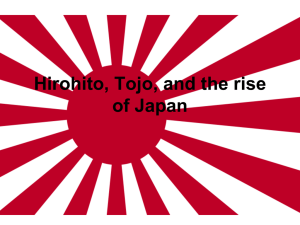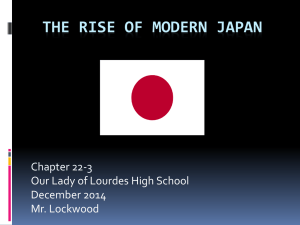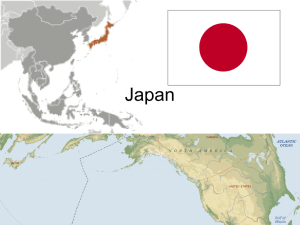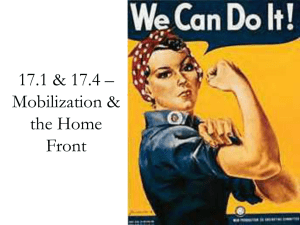Japan After World War I Creating a New Culture In the Meiji Period
advertisement
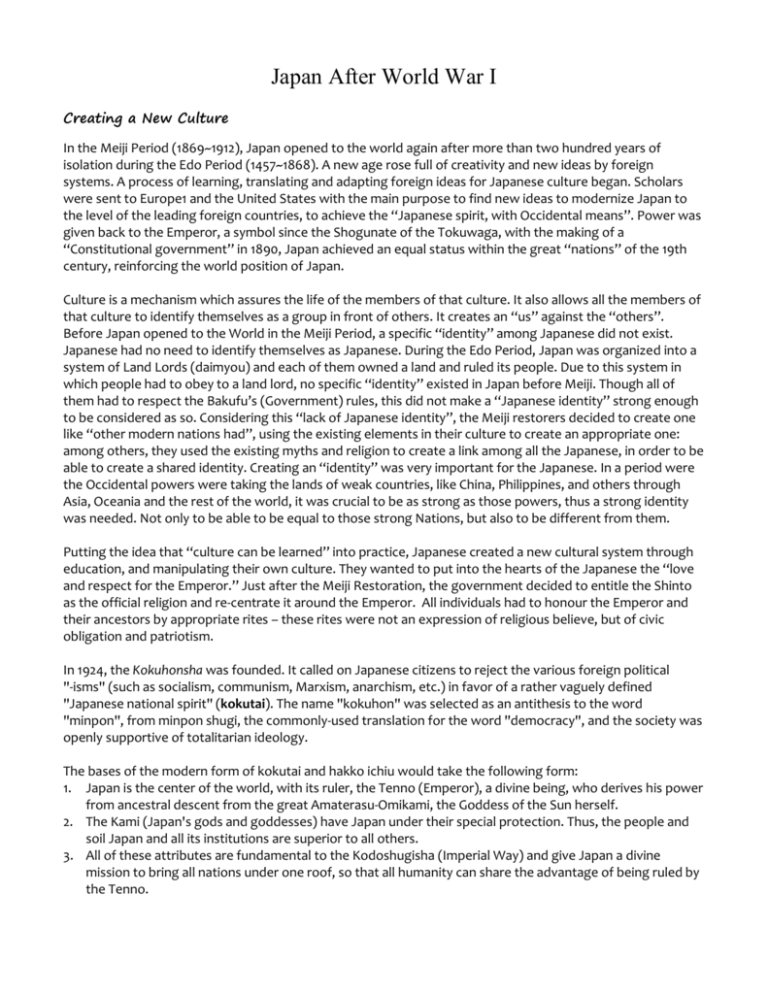
Japan After World War I Creating a New Culture In the Meiji Period (1869~1912), Japan opened to the world again after more than two hundred years of isolation during the Edo Period (1457~1868). A new age rose full of creativity and new ideas by foreign systems. A process of learning, translating and adapting foreign ideas for Japanese culture began. Scholars were sent to Europe1 and the United States with the main purpose to find new ideas to modernize Japan to the level of the leading foreign countries, to achieve the “Japanese spirit, with Occidental means”. Power was given back to the Emperor, a symbol since the Shogunate of the Tokuwaga, with the making of a “Constitutional government” in 1890, Japan achieved an equal status within the great “nations” of the 19th century, reinforcing the world position of Japan. Culture is a mechanism which assures the life of the members of that culture. It also allows all the members of that culture to identify themselves as a group in front of others. It creates an “us” against the “others”. Before Japan opened to the World in the Meiji Period, a specific “identity” among Japanese did not exist. Japanese had no need to identify themselves as Japanese. During the Edo Period, Japan was organized into a system of Land Lords (daimyou) and each of them owned a land and ruled its people. Due to this system in which people had to obey to a land lord, no specific “identity” existed in Japan before Meiji. Though all of them had to respect the Bakufu’s (Government) rules, this did not make a “Japanese identity” strong enough to be considered as so. Considering this “lack of Japanese identity”, the Meiji restorers decided to create one like “other modern nations had”, using the existing elements in their culture to create an appropriate one: among others, they used the existing myths and religion to create a link among all the Japanese, in order to be able to create a shared identity. Creating an “identity” was very important for the Japanese. In a period were the Occidental powers were taking the lands of weak countries, like China, Philippines, and others through Asia, Oceania and the rest of the world, it was crucial to be as strong as those powers, thus a strong identity was needed. Not only to be able to be equal to those strong Nations, but also to be different from them. Putting the idea that “culture can be learned” into practice, Japanese created a new cultural system through education, and manipulating their own culture. They wanted to put into the hearts of the Japanese the “love and respect for the Emperor.” Just after the Meiji Restoration, the government decided to entitle the Shinto as the official religion and re-centrate it around the Emperor. All individuals had to honour the Emperor and their ancestors by appropriate rites – these rites were not an expression of religious believe, but of civic obligation and patriotism. In 1924, the Kokuhonsha was founded. It called on Japanese citizens to reject the various foreign political "-isms" (such as socialism, communism, Marxism, anarchism, etc.) in favor of a rather vaguely defined "Japanese national spirit" (kokutai). The name "kokuhon" was selected as an antithesis to the word "minpon", from minpon shugi, the commonly-used translation for the word "democracy", and the society was openly supportive of totalitarian ideology. The bases of the modern form of kokutai and hakko ichiu would take the following form: 1. Japan is the center of the world, with its ruler, the Tenno (Emperor), a divine being, who derives his power from ancestral descent from the great Amaterasu-Omikami, the Goddess of the Sun herself. 2. The Kami (Japan's gods and goddesses) have Japan under their special protection. Thus, the people and soil Japan and all its institutions are superior to all others. 3. All of these attributes are fundamental to the Kodoshugisha (Imperial Way) and give Japan a divine mission to bring all nations under one roof, so that all humanity can share the advantage of being ruled by the Tenno. The policies of kokutai and hakko ichiu rested on the Japanese people having a leader with spiritual or mythic origins. In school, Japanese school children were taught that they should put the nation before the self and that they were part of the state and not separate from it. Soon the government began to engrain the ideal that all Japanese citizens where to follow the teachings of loyalty and family devotion, which would throw aside selfishness and allow them to complete their "holy task” of bring Japan to “rule from the top of the world.” Finally, the concept of Bushido was modified to fit the overall totalitarian goal of the Japanese government in the 1930s. Bushido was the warrior code and laws of feudal Japan. In later years, the code of Bushido found resurgence in belief following the Meiji Restoration of the 1800s. At first, this allowed Japan to field what was considered one of the most professional and humane militaries in the world, one respected by friend and foe alike. Eventually, however, this belief would become a combination of propaganda and radicalism that would lead to the Second Sino-Japanese War of the 1930s and World War II. Political Changes When Emperor Hirohito ascended to the throne in 1926, Japan was enveloped in a struggle between liberals and leftists on one side, and ultraconservatives on the other. In 1925, universal male suffrage was introduced, increasing the electorate from 3.3 to 12.5 million. Yet as the left pushed for further democratic reforms, rightwing politicians pushed for legislation to ban organizations that threatened the state by advocating wealth distribution or political change. Although early ultra-nationalists called for a tempering of Japan’s ‘westernization’, through limits on industrialization, their focus changed after the First World War. Western politicians criticized Japan’s imperial ambitions and limited Japanese military expansion (in 1922’s Five Power Naval Limitation Agreement). The 1924 Japanese Exclusion Act prohibited Japanese immigration into the US. Ultra-nationalists saw these actions as provocative; they moved towards xenophobic, emperor-centered and Asia-centric positions, portraying the ‘ABCD Powers’ (America-British-Chinese-Dutch) as threatening the Japanese Empire. In addition, Japan faced domestic turmoil between 1928 and 1932. Economic collapse associated with the Great Depression provoked spiraling prices, unemployment, falling exports and social unrest. In November 1930, the Prime Minister Hamaguchi Osachi was shot by an ultra-nationalist. In summer 1931, as control slipped away from the civilian government, the army acted independently to invade Manchuria. Troops quickly conquered the entire border region, establishing the puppet state of Manchukuo. Though the League of Nations condemned the action, it was powerless to intervene, and Japan promptly withdrew its membership. International isolation fed ultra-nationalism. Mayors, teachers and Shinto priests were recruited by ultranationalist movements to indoctrinate citizens. In May 1932, an attempt by army officers to assassinate Prime Minister Hamaguchi’s successor stopped short of becoming a full-blown coup, but ended rule by political parties. Between 1932 and 1936, admirals ruled Japan. Within government, the idea of the ‘Greater East Asian Co-Prosperity Sphere’ emerged. This plan called for Asian unification against western imperialism under Japanese leadership, leading to Asian self-sufficiency and prosperity. In reality, it meant an agenda of Japanese imperial domination in the Far East. The Japanese were proud of their many accomplishments and resented racial slurs they met with in some Western nations. The military was convinced of the willingness of its people to go to any sacrifice for their nation, and it was contemptuous of the "softness" of the U.S. and European democracies, where loyalty and patriotism were tempered by the rights and well-being of the individual. The military's overconfidence in its own abilities and underestimation of the will of these other nations were thus rooted in its own misleading ethnic and racial stereotypes. While Asians, the Japanese saw themselves less as representatives of Asia than as Asia's champion. They sought to liberate Asian colonies from the Westerners, whom they disdained. But although the Japanese were initially welcomed in some Asian colonies by the indigenous populations whom they "liberated" from European domination, the arrogance and racial prejudice displayed by the Japanese military governments in these nations created great resentment. This resentment is still evident in some Southeast Asian nations.



